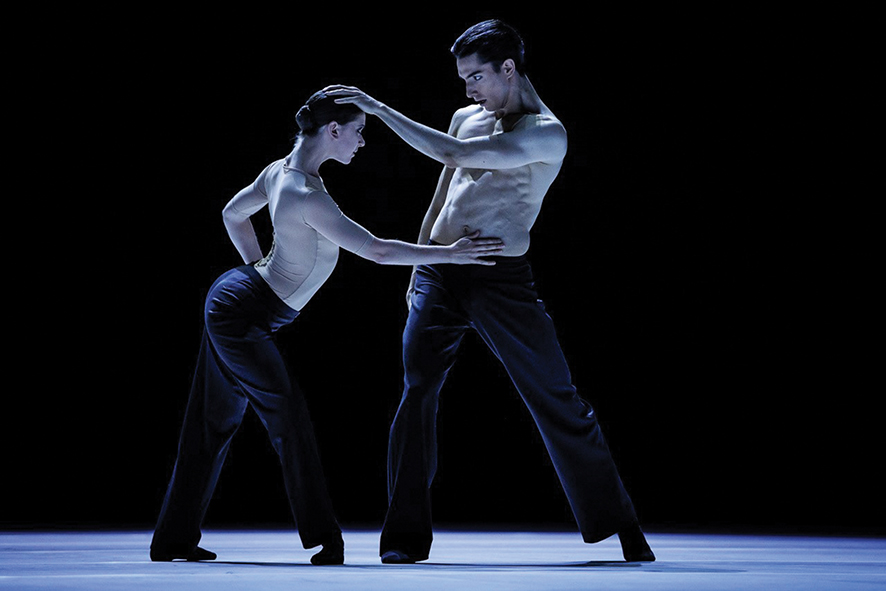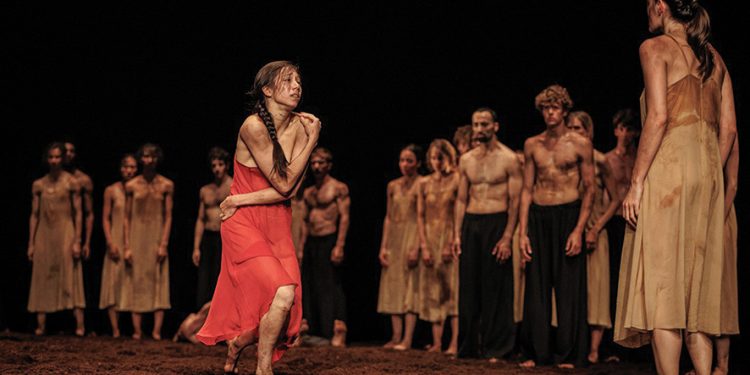Traditional notions of love, duty, and societal expectations are the main topics of Nino Haratishvili’s play “Phädra in Flames” that premiered on the second of June 2023 at the Berliner Ensemble. Loosely based on Seneca’s classic tragedy Phädra the play attempts to challenge preconceived notions of gender, sexuality, and the complexities of human connections, ultimately showcasing the profound impact of hidden desires on the lives of individuals and the society they inhabit. The emotionally charged performances of the main cast took audiences to explore the depths of human desires and the consequences that come with pursuing forbidden passions. Constanze Becker starring as Phädra, Oliver Kraushaar as Theseus, Lili Epply as the beautiful Persea, Maximilian Diehle as Demophon delivered inspiring performances full of tension and sincerity. The precision of body language and posture was at times more eloquent than words.
Nino Haratishvili’s newest play evidently aims to explore the themes of ageing, female fate, disillusionment and Sapphic love in contemporary societies from a female perspective. Although these topics are of utmost urgency and importance the play comes through as rather didactic and predictable, the characters developed by the author are less convincing. Lengthy monologues lacking significant action call for more intensity and dynamics. Nonetheless on the whole more women playwrights and more theatre productions staged by women and focussing on female perspectives are definitely a positive sign in the male dominated theatre domain.
“Phädra in Flammen” was created within the framework of the BE-Dramatiker:innen Fund supported by the Heinz und Heide Dürr Foundation, stage direction is done by Nanouk Leopold.
Another memorable event of the Berlin summer season has been the premiere of the new stagings of Igor Strawinsky’s masterpieces “Petrushka” and “Sacre du Printemps” at the Staatsbalett Berlin. Igor Stravinsky was a renowned Russian composer, widely considered one of the most influential composers of the 20th century. He was known for his innovative approach to music and his collaborations with the Ballets Russes, a ballet company founded by Sergei Diaghilev.
Stravinsky’s collaboration with the Ballets Russes began in 1909 with the ballet “The Firebird,” which catapulted him to international fame. It was followed by other groundbreaking ballets, including “Petrushka” (1911) and “The Rite of Spring” (1913). These works, with their rhythmic complexities, dissonance, and unconventional use of instruments, challenged traditional musical conventions and pushed the boundaries of composition.
“The Rite of Spring,” in particular, caused a sensation and sparked a riot during its premiere due to its avant-garde nature and provocative choreography by Vaslav Nijinsky. Since its premiere, “The Rite of Spring” has been restaged and reimagined by numerous choreographers over the years, each bringing their own interpretations and artistic visions to the work. Pina Bauch interpretation of the piece that premiered in Berlin was met with well-deserved admiration from the public and standing ovations.

A renowned German choreographer and dancer Pina Bausch was known for her groundbreaking works in contemporary dance theater. She was associated with the Tanztheater movement, which blended elements of dance, theater, and performance art. The choreography for “The Rite of Spring” developed by her is characterized for its raw, earthbound, and primal movements. It draws inspiration from Russian folk dance, pagan rituals, and the concept of ancient sacrificial rites. The dancers’ movements often mimic natural elements, such as stomping, leaping, and crawling, reflecting a sense of primordial energy and physicality. Sharp and angular shapes, with twisted torsos, flexed feet, and jutting limbs offer an ecstatic impact. The bodies create asymmetrical positions and dynamic lines that emphasize the tension and angularity of the movements. Group dynamics incorporate intricate and complex formations e.g. circular movement patterns with alignments of bodies constantly diffusing and reuniting. Large ensembles of dancers move together in unison or counterpoint, creating a sense of collective energy and communal rituals. The choreography highlights the dynamics of the group, with synchronized movements, canon-like sequences, and geometric configurations. Pina Bausch’s well researched repertoire of gestures, poses, moves is emotionally charged to the extreme. The choreography of “The Rite of Spring” incorporates ritualistic gestures and symbolic actions. These often convey themes of sacrifice, rebirth, and the cycle of life. The unconventional peat-covered stage requires the dancers to go to their physical limits. They have to dance, as Pina Bausch conceived it, for their lives.
The piece is co-produced by the Staatsballett Berlin and the Pina Bausch Foundation.
If “The Rite of Spring” is an orchestral work by Igor Stravinsky, “Petrushka” is one of his ballets. It is from now on part of the repertory of the Staatsbalett Berlin. “Petrushka” originally featured choreography by Michel Fokine, who collaborated with Stravinsky on several ballets for the Ballets Russes.
The current interpretation of “Petrushka” by choreographer Marco Goecke is a beautiful example of the permanent process of renewal of established dance forms that evolve with time to remain relevant for contemporary societies in ever changing cultural contexts. The settings and costumes by Michaela Springer who opted for the overall reduced black and white colour palette was at times a bit problematic since the dancer’s lower body-parts were hardly recognisable against the dark background of the settings.
Marco Goecke’s choreography for “Petrushka” is full of vibrant expressive movements, the whole piece is rendered exceptionally rhythmic and pulsating with energies, the portrayal of vivid characters is remarkably contemporary. Strawinsky’s music for this ballet inspired by Russian folk-tunes is energetic and colourful. In the restaged version the dancers’ movements mimic the wild tempo and joyful spirit of Strawinsky’s score. Visual effects enhancing the perception of music through bodily movements and silhouettes are spectacular, elegant and convey the aura of clown-like lightness, tongue-in-cheek humour and mockery of a jester.
The piece tells the tale of three puppets—Petrushka, the Moor, and the Ballerina—brought to life in a Russian fairground. Goecke’s choreography captures the individual personalities of the puppets and the dynamics between them. Petrushka, the hapless and love-struck puppet, is characterized by his awkward movements and gestures, conveying his vulnerability and longing. The Moor, a strong and aggressive puppet, displays powerful and athletic movements. The Ballerina, graceful and delicate, embodies elegance and lyricism in her choreography.
In addition to character-driven movements, Goecke’s choreography features lively group scenes and ensemble work, bringing the fairground atmosphere to life. The dances of the masqueraders, the waltzing, and the energetic Russian dance sequences contribute to the ballet’s overall liveliness.
The combination of Goecke’s choreography and Stravinsky’s shifting rhythms and evocative melodies creates a vibrant and engaging theatrical experience. Last but not least the protagonist of the Moore has been carefully investigated and revamped, freed from the stigmatising racist and prejudiced interpretation of this character in the original stagings.
Review by Lily Fürstenow














